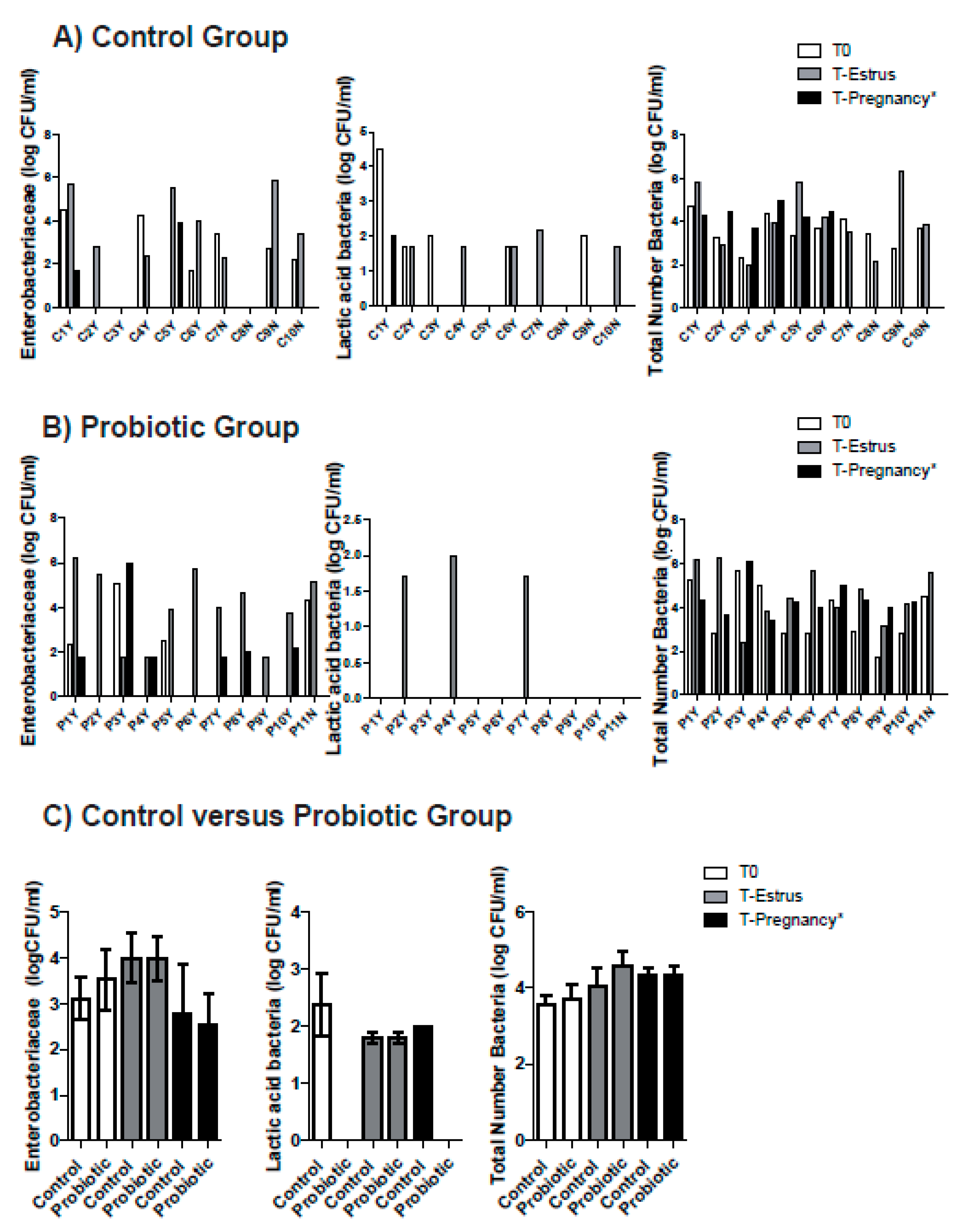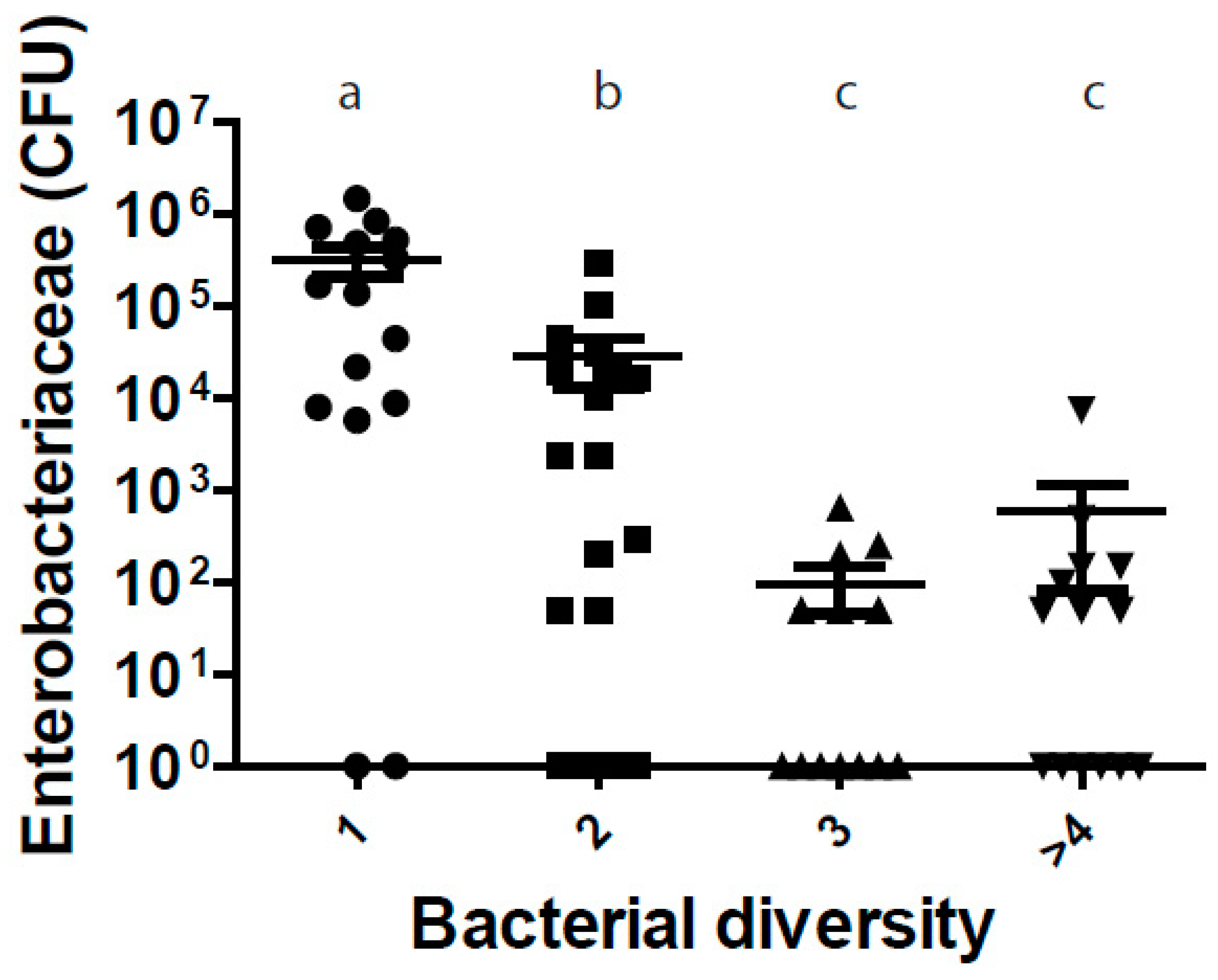Use of Probiotics in Intravaginal Sponges in Sheep: A Pilot Study
Abstract
Simple Summary
Abstract
1. Introduction
2. Materials and Methods
2.1. Ethics Statement
2.2. Animals and Experimental Design
2.3. Bacteria Isolation and Quantification
- T0—The day of the sponge insertion.
- T-Estrus—Two days after sponge removal.
- T-Pregnancy—The day of pregnancy diagnosis, 50 days after sponge removal. At this time, only the ewes that were confirmed pregnant ultrasonographically were studied in order to have ewes with the same hormonal environment.
2.4. Vaginal Microbial Diversity
2.5. Vaginal Cytology
2.6. Probiotic Inoculation
2.7. Statistical Analysis
3. Results
3.1. Vaginal Microbiota and Cytology Changes after Intravaginal Sponge Removal in the Control and Probiotic Groups
3.2. Probiotic Inoculation Effect on General Health Status, Fertility and Prolificity
3.3. Vaginal Microbial Diversity is Related to Enterobacteriaceae Counts
4. Discussion
5. Conclusions
Author Contributions
Funding
Acknowledgments
Conflicts of Interest
References
- Abecia, J.A.; Forcada, F.; Gonzalez-Bulnes, A. Hormonal control of reproduction in small ruminants. Anim. Reprod. Sci. 2012, 130, 173–179. [Google Scholar] [CrossRef] [PubMed]
- Abecia, J.A.; Forcada, F.; Zuniga, O. Differences in reproductive performance, embryo development, interferon-tau secretion by the conceptus and luteal function in ewe lambs synchronized in oestrus before or after the spontaneous onset of luteal activity preceding puberty. Reprod. Domest. Anim. 2001, 36, 73–77. [Google Scholar] [CrossRef]
- Manes, J.; Campero, C.; Hozbor, F.; Alberio, R.; Ungerfeld, R. Vaginal histological changes after using intravaginal sponges for oestrous synchronization in anoestrous ewes. Reprod. Domest. Anim. 2015, 50, 270–274. [Google Scholar] [CrossRef] [PubMed]
- Manes, J.; Fiorentino, M.A.; Kaiser, G.; Hozbor, F.; Alberio, R.; Sanchez, E.; Paolocchi, F. Changes in the aerobic vaginal flora after treatment with different intravaginal devices in ewes. Small Rumin. Res. 2010, 94, 201–204. [Google Scholar] [CrossRef]
- Scudamore, C.L. Intravaginal sponge insertion technique. Vet. Rec. 1988, 123, 554. [Google Scholar] [CrossRef]
- Gonzalez-Bulnes, A.; Veiga-Lopez, A.; Garcia, P.; Garcia-Garcia, R.M.; Ariznavarreta, C.; Sanchez, M.A.; Tresguerres, J.A.; Cocero, M.J.; Flores, J.M. Effects of progestagens and prostaglandin analogues on ovarian function and embryo viability in sheep. Theriogenology 2005, 63, 2523–2534. [Google Scholar] [CrossRef]
- Manes, J.; Rios, G.; Fiorentino, M.A.; Ungerfeld, R. Vaginal mucus from ewes treated with progestogen sponges affects quality of ram spermatozoa. Theriogenology 2016, 85, 856–861. [Google Scholar] [CrossRef]
- Martinez-Ros, P.; Lozano, M.; Hernandez, F.; Tirado, A.; Rios-Abellan, A.; Lopez-Mendoza, M.C.; Gonzalez-Bulnes, A. Intravaginal Device-Type and Treatment-Length for Ovine Estrus Synchronization Modify Vaginal Mucus and Microbiota and Affect Fertility. Animals (Basel) 2018, 8. [Google Scholar] [CrossRef]
- Gatti, M.; Zunino, P.; Ungerfeld, R. Changes in the aerobic vaginal bacterial mucous load after treatment with intravaginal sponges in anoestrous ewes: Effect of medroxiprogesterone acetate and antibiotic treatment use. Reprod. Domest. Anim. 2011, 46, 205–208. [Google Scholar] [CrossRef]
- Ojeda-Hernandez, F.; del Moral-Ventura, S.; Capataz-Tafur, J.; Pena-Castro, J.; Abad-Zavaleta, J.; Chay-Canul, A.; Ramon-Ugalde, J.; Ungerfeld, R.; Meza-Villalvazo, V. Vaginal microbiota in Pelibuey sheep treated with antimicrobials at the removal of intravaginal sponges impregnated with flurogestone acetate. Small Rumin. Res. 2019, 170, 116–119. [Google Scholar] [CrossRef]
- Romero, T.; Balado, J.; Althaus, R.L.; Beltran, M.C.; Molina, M.P. Short communication: Drug residues in goat milk after prophylactic use of antibiotics in intravaginal sponges for estrus synchronization. J. Dairy Sci. 2016, 99, 141–145. [Google Scholar] [CrossRef] [PubMed]
- Ma, B.; Forney, L.J.; Ravel, J. Vaginal microbiome: Rethinking health and disease. Annu. Rev. Microbiol. 2012, 66, 371–389. [Google Scholar] [CrossRef] [PubMed]
- Petricevic, L.; Domig, K.J.; Nierscher, F.J.; Sandhofer, M.J.; Fidesser, M.; Krondorfer, I.; Husslein, P.; Kneifel, W.; Kiss, H. Characterisation of the vaginal Lactobacillus microbiota associated with preterm delivery. Sci. Rep. 2014, 4, 5136. [Google Scholar] [CrossRef] [PubMed]
- Li, J.; McCormick, J.; Bocking, A.; Reid, G. Importance of vaginal microbes in reproductive health. Reprod. Sci. 2012, 19, 235–242. [Google Scholar] [CrossRef]
- Lagier, J.C.; Dubourg, G.; Million, M.; Cadoret, F.; Bilen, M.; Fenollar, F.; Levasseur, A.; Rolain, J.M.; Fournier, P.E.; Raoult, D. Culturing the human microbiota and culturomics. Nat. Rev. Microbiol. 2018, 16, 540–550. [Google Scholar] [CrossRef]
- Deng, Q.; Odhiambo, J.F.; Farooq, U.; Lam, T.; Dunn, S.M.; Ametaj, B.N. Intravaginal lactic Acid bacteria modulated local and systemic immune responses and lowered the incidence of uterine infections in periparturient dairy cows. PLoS ONE 2014, 10, e0124167. [Google Scholar] [CrossRef]
- Deng, Q.; Odhiambo, J.F.; Farooq, U.; Lam, T.; Dunn, S.M.; Ganzle, M.G.; Ametaj, B.N. Intravaginally administered lactic acid bacteria expedited uterine involution and modulated hormonal profiles of transition dairy cows. J. Dairy Sci. 2015, 98, 6018–6028. [Google Scholar] [CrossRef]
- Genis, S.; Bach, A.; Fabregas, F.; Aris, A. Potential of lactic acid bacteria at regulating Escherichia coli infection and inflammation of bovine endometrium. Theriogenology 2016, 85, 625–637. [Google Scholar] [CrossRef]
- Genis, S.; Sanchez-Chardi, A.; Bach, A.; Fabregas, F.; Aris, A. A combination of lactic acid bacteria regulates Escherichia coli infection and inflammation of the bovine endometrium. J. Dairy Sci. 2017, 100, 479–492. [Google Scholar] [CrossRef]
- Swartz, J.D.; Lachman, M.; Westveer, K.; O’Neill, T.; Geary, T.; Kott, R.W.; Berardinelli, J.G.; Hatfield, P.G.; Thomson, J.M.; Roberts, A.; et al. Characterization of the Vaginal Microbiota of Ewes and Cows Reveals a Unique Microbiota with Low Levels of Lactobacilli and Near-Neutral pH. Front. Vet. Sci. 2014, 1, 19. [Google Scholar] [CrossRef]
- Rodriguez-Palacios, A.; Aladyshkina, N.; Ezeji, J.C.; Erkkila, H.L.; Conger, M.; Ward, J.; Webster, J.; Cominelli, F. ‘Cyclical Bias’ in Microbiome Research Revealed by A Portable Germ-Free Housing System Using Nested Isolation. Sci. Rep. 2018, 8, 3801. [Google Scholar] [CrossRef] [PubMed]
- Groppetti, D.; Pecile, A.; Barbero, C.; Martino, P.A. Vaginal bacterial flora and cytology in proestrous bitches: Role on fertility. Theriogenology 2012, 77, 1549–1556. [Google Scholar] [CrossRef] [PubMed]
- Gomez-Martin, A.; De la Fe, C.; Amores, J.; Sanchez, A.; Contreras, A.; Paterna, A.; Buendia, A.J.; Corrales, J.C. Anatomic location of Mycoplasma mycoides subsp. capri and Mycoplasma agalactiae in naturally infected goat male auricular carriers. Vet. Microbiol. 2012, 157, 355–362. [Google Scholar] [CrossRef] [PubMed]
- Weese, J.S.; Martin, H. Assessment of commercial probiotic bacterial contents and label accuracy. Can. Vet. J. 2011, 52, 43–46. [Google Scholar] [PubMed]
- Clemmons, B.A.; Reese, S.T.; Dantas, F.G.; Franco, G.A.; Smith, T.P.L.; Adeyosoye, O.I.; Pohler, K.G.; Myer, P.R. Vaginal and Uterine Bacterial Communities in Postpartum Lactating Cows. Front. Microbiol. 2017, 8, 1047. [Google Scholar] [CrossRef] [PubMed]
- Laguardia-Nascimento, M.; Branco, K.M.; Gasparini, M.R.; Giannattasio-Ferraz, S.; Leite, L.R.; Araujo, F.M.; Salim, A.C.; Nicoli, J.R.; de Oliveira, G.C.; Barbosa-Stancioli, E.F. Vaginal Microbiome Characterization of Nellore Cattle Using Metagenomic Analysis. PLoS ONE 2015, 10, e0143294. [Google Scholar] [CrossRef]
- Ault, T.B.; Clemmons, B.A.; Reese, S.T.; Dantas, F.G.; Franco, G.A.; Smith, T.P.L.; Edwards, J.L.; Myer, P.R.; Pohler, K.G. Uterine and vaginal bacterial community diversity prior to artificial insemination between pregnant and nonpregnant postpartum cows1. J. Anim. Sci. 2019, 97, 4298–4304. [Google Scholar] [CrossRef]
- Santos, T.M.; Bicalho, R.C. Diversity and succession of bacterial communities in the uterine fluid of postpartum metritic, endometritic and healthy dairy cows. PLoS ONE 2012, 7, e53048. [Google Scholar] [CrossRef]
- Jeon, S.J.; Vieira-Neto, A.; Gobikrushanth, M.; Daetz, R.; Mingoti, R.D.; Parize, A.C.; de Freitas, S.L.; da Costa, A.N.; Bicalho, R.C.; Lima, S.; et al. Uterine Microbiota Progression from Calving until Establishment of Metritis in Dairy Cows. Appl. Environ. Microbiol. 2015, 81, 6324–6332. [Google Scholar] [CrossRef]
- Martins, G.; Figueira, L.; Penna, B.; Brandão, F.; Varges, R.; Vasconcelos, C.; Lilenbaum, W. Prevalence and antimicrobial susceptibility of vaginal bacteria from ewes treated with progestin-impregnated intravaginal sponges. Small Rumin. Res. 2009, 81, 182–184. [Google Scholar] [CrossRef]
- Falagas, M.E.; Betsi, G.I.; Tokas, T.; Athanasiou, S. Probiotics for prevention of recurrent urinary tract infections in women: A review of the evidence from microbiological and clinical studies. Drugs 2006, 66, 1253–1261. [Google Scholar] [CrossRef] [PubMed]
- Otero, M.C.; Morelli, L.; Nader-Macias, M.E. Probiotic properties of vaginal lactic acid bacteria to prevent metritis in cattle. Lett. Appl. Microbiol. 2006, 43, 91–97. [Google Scholar] [CrossRef] [PubMed]
- Mosca, A.; Leclerc, M.; Hugot, J.P. Gut Microbiota Diversity and Human Diseases: Should We Reintroduce Key Predators in Our Ecosystem? Front. Microbiol. 2016, 7, 455. [Google Scholar] [CrossRef] [PubMed]
- Miranda-CasoLuengo, R.; Lu, J.; Williams, E.J.; Miranda-CasoLuengo, A.A.; Carrington, S.D.; Evans, A.C.O.; Meijer, W.G. Delayed differentiation of vaginal and uterine microbiomes in dairy cows developing postpartum endometritis. PLoS ONE 2019, 14, e0200974. [Google Scholar] [CrossRef] [PubMed]


| Time | Bacterial Isolation | Control Group | Probiotic Group |
|---|---|---|---|
| T0 | Enterobacteriaceae | 3.11 ± 1.12 | 3.29 ± 1.35 |
| Total Number of Bacteria | 3.56 ± 0.72 | 3.68 ± 1.30 | |
| T-Estrus | Enterobacteriaceae | 4 ± 1.31 | 4 ± 1.66 |
| Total Number of Bacteria | 4.05 ± 1.53 | 4.58 ± 1.26 | |
| T-Pregnancy | Enterobacteriaceae | 2.79 ± 1.54 | 2.53 ± 1.67 |
| Total Number of Bacteria | 4.32 ± 0.48 | 4.34 ± 0.76 |
© 2020 by the authors. Licensee MDPI, Basel, Switzerland. This article is an open access article distributed under the terms and conditions of the Creative Commons Attribution (CC BY) license (http://creativecommons.org/licenses/by/4.0/).
Share and Cite
Quereda, J.J.; García-Roselló, E.; Barba, M.; Mocé, M.L.; Gomis, J.; Jiménez-Trigos, E.; Bataller, E.; Martínez-Boví, R.; García-Muñoz, Á.; Gómez-Martín, Á. Use of Probiotics in Intravaginal Sponges in Sheep: A Pilot Study. Animals 2020, 10, 719. https://doi.org/10.3390/ani10040719
Quereda JJ, García-Roselló E, Barba M, Mocé ML, Gomis J, Jiménez-Trigos E, Bataller E, Martínez-Boví R, García-Muñoz Á, Gómez-Martín Á. Use of Probiotics in Intravaginal Sponges in Sheep: A Pilot Study. Animals. 2020; 10(4):719. https://doi.org/10.3390/ani10040719
Chicago/Turabian StyleQuereda, Juan J., Empar García-Roselló, Marta Barba, María L. Mocé, Jesús Gomis, Estrella Jiménez-Trigos, Esther Bataller, Rebeca Martínez-Boví, Ángel García-Muñoz, and Ángel Gómez-Martín. 2020. "Use of Probiotics in Intravaginal Sponges in Sheep: A Pilot Study" Animals 10, no. 4: 719. https://doi.org/10.3390/ani10040719
APA StyleQuereda, J. J., García-Roselló, E., Barba, M., Mocé, M. L., Gomis, J., Jiménez-Trigos, E., Bataller, E., Martínez-Boví, R., García-Muñoz, Á., & Gómez-Martín, Á. (2020). Use of Probiotics in Intravaginal Sponges in Sheep: A Pilot Study. Animals, 10(4), 719. https://doi.org/10.3390/ani10040719






